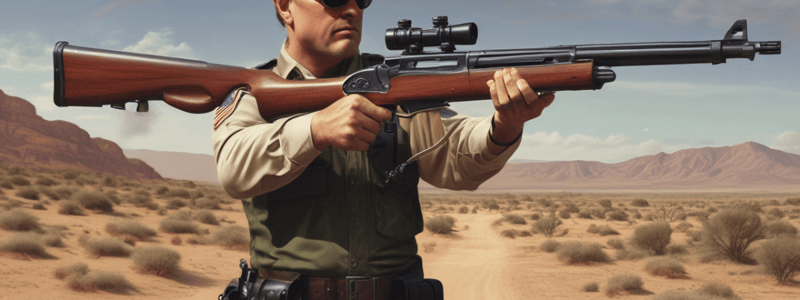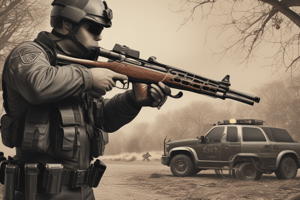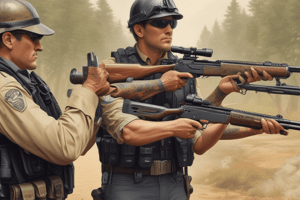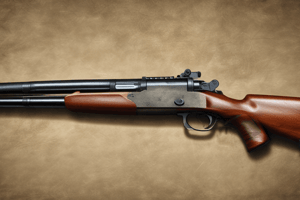Podcast
Questions and Answers
What is the primary objective of the shotgun instructor during the 12-hour range time?
What is the primary objective of the shotgun instructor during the 12-hour range time?
- To provide additional instruction and demonstration of skills (correct)
- To focus solely on combat conditions
- To teach recruits how to handle Remington 870 only
- To teach recruits how to use Mossberg shotguns in standing positions only
What is the purpose of the live fire exercises at the Range?
What is the purpose of the live fire exercises at the Range?
- To build on previous skills taught and prepare for shotgun qualification (correct)
- To teach recruits how to handle shotgun malfunctions
- To qualify recruits for shotgun use
- To practice skeet shooting only
In what position is the recruit taught to mount the shotgun?
In what position is the recruit taught to mount the shotgun?
- Sitting only
- Standing, kneeling, and prone positions (correct)
- Crouching only
- Lying down only
What is the objective of the Assembly Area Load Position?
What is the objective of the Assembly Area Load Position?
What is the purpose of the High Ready tactical combat carry position?
What is the purpose of the High Ready tactical combat carry position?
What is the objective of the course at the Arnold Gun Club?
What is the objective of the course at the Arnold Gun Club?
What is the primary purpose of the Demonstration of Inspection and Assembly Area Loading?
What is the primary purpose of the Demonstration of Inspection and Assembly Area Loading?
What is the primary benefit of using the Weaver stance?
What is the primary benefit of using the Weaver stance?
What is the proper way to position the strong side foot in the Isosceles stance?
What is the proper way to position the strong side foot in the Isosceles stance?
What is the purpose of thrusting the head forward in the Isosceles stance?
What is the purpose of thrusting the head forward in the Isosceles stance?
What is the proper way to mount the shotgun in the standing position?
What is the proper way to mount the shotgun in the standing position?
What is the purpose of the prone position?
What is the purpose of the prone position?
What is the fifth fundamental of marksmanship?
What is the fifth fundamental of marksmanship?
What is the purpose of demonstrating the procedures for clearing shooter-induced malfunctions?
What is the purpose of demonstrating the procedures for clearing shooter-induced malfunctions?
What is the first step in assuming the prone position?
What is the first step in assuming the prone position?
What is the purpose of the supported kneeling position?
What is the purpose of the supported kneeling position?
What is the primary purpose of the high ready tactical combat carrying position?
What is the primary purpose of the high ready tactical combat carrying position?
In which carry position is the muzzle directed to the ground forward and to the side of the strong leg?
In which carry position is the muzzle directed to the ground forward and to the side of the strong leg?
What is the primary advantage of the Low Ready position?
What is the primary advantage of the Low Ready position?
What is the purpose of the Carry 1 position?
What is the purpose of the Carry 1 position?
In which carry position is the muzzle held at a 45-degree angle across the body?
In which carry position is the muzzle held at a 45-degree angle across the body?
What is the primary purpose of the Vertical Carry position?
What is the primary purpose of the Vertical Carry position?
In which carry position is the action left open and the safety is on?
In which carry position is the action left open and the safety is on?
What is the purpose of the Carry 2 position?
What is the purpose of the Carry 2 position?
In which carry position is the stock of the weapon at waist level?
In which carry position is the stock of the weapon at waist level?
Where is the fore-end of the weapon placed in the Carry 2 position?
Where is the fore-end of the weapon placed in the Carry 2 position?
Flashcards are hidden until you start studying
Study Notes
Shotgun Instructor Lesson Plan
- The lesson plan is designed to provide recruits with the opportunity to demonstrate skills and receive additional instruction during range time with the shotguns provided by the JCLEA.
- The recruits will have the opportunity to use both the Remington 870 and the Mossberg shotguns.
Objectives
- Demonstrate the proper inspection and assembly area loading procedure.
- Demonstrate the proper method(s) of loading the shotgun under combat conditions.
- Demonstrate the proper method of unloading the shotgun from both the assembly area load position and combat load position.
- Demonstrate the proper mounting of the shotgun in the standing, kneeling, and prone positions.
- Demonstrate the five fundamentals of marksmanship in the operation of the shotgun.
- Demonstrate the correct procedure for clearing the most common shooter-induced malfunctions of the shotgun.
- Demonstrate the High Ready and Low Ready tactical combat carry positions.
Instruction
- During the next 12(+) hours, recruits will spend time at the Range practicing the skills learned in live fire exercises as well as time at the skeet shooting range at the Arnold Gun Club.
- Each block of instruction at the Range will build on the previous skills taught and demonstrated, leading up to shotgun qualification.
Shotgun Mounting Positions
- Standing Position:
- Weaver Stance:
- Boxer Stance, feet shoulder-width apart at approximately a 45-degree angle to the target, support foot forward.
- Body weight shifted forward on front (support foot).
- Head in upright position, back straight when mounting the weapon.
- Position of hands on weapon:
- Support hand grips the fore-end grip.
- Strong hand holds the pistol grip of stock.
- Index (trigger) finger alongside the trigger guard.
- Shouldering of weapon:
- Comb of stock brought up to the face of the shooter, contacting the cheekbone.
- Stock is slid rearward until the butt of the weapon contacts the shoulder pocket area.
- Head stays upright; weapon is brought to the shooter's line of sight.
- Support hand elbow is pointed down to support the fore-end of the weapon.
- Weapon is pulled firmly into the pocket area and held until the weapon has been fired.
- Isosceles Stance:
- The strong side foot should be online with or 2-6 inches behind the toe of the support foot.
- The upper body should be squared to the target with a forward lean of approximately 2-4 inches.
- Elbows should be pointed down toward the ground.
- The head should be thrust forward and the eyes should be focused on the threat.
- When the firearm is presented to the target, it should come to eye level, and the head should not move.
- The butt of the stock is held against the strong side pectoral muscle of the shooter's chest.
- Weaver Stance:
- Kneeling Position:
- UNSUPPORTED:
- From standard (Boxer stance) standing position, kneel straight down onto the strong knee.
- Keep back and upper torso straight, head up.
- Weapon is mounted just as in standing position.
- Body weight is shifted slightly forward when preparing to fire.
- Front (support) foot should be placed with the sole of the foot flat on the ground.
- SUPPORTED:
- From Boxer stance, standing position, kneel down onto the strong knee.
- After kneeling, sit back on the heel of the strong foot.
- Elbow of support arm is supported on upright knee.
- Body weight is shifted forward when preparing to fire.
- Support foot should be placed firmly on the ground.
- UNSUPPORTED:
- Prone Position:
- From a standing position, the shooter should squat straight down, place their support hand directly out in front of them, kick their feet out to the rear, and then "lock up" or brace the position.
- This position is braced by bringing the support hand under the fore-end of the shotgun, while simultaneously bringing the support leg up in a bent position.
- The shotgun should then be properly indexed as mentioned earlier.
Marksmanship Fundamentals
- Five fundamentals of marksmanship:
- Stance
- Grip
- Sighting
- Trigger Action
- Breathing
Clearing Malfunctions
- Demonstrate the correct procedure for clearing the most common shooter-induced malfunctions of the shotgun.
Tactical Combat Carry Positions
- High Ready:
- The weapon is held forward of the body with the muzzle at centerline and eye level.
- The support hand grips the fore-end and the strong hand is on the "pistol grip".
- The stock of the weapon should be at waist level.
- The trigger finger is outside the trigger guard with the safety on.
- Low Ready:
- The weapon is shoulder mounted with the muzzle depressed across the body at a 45-degree angle.
- Lowering the muzzle gets it out of the way in tight areas; muzzle does not block view, and relieves fatigue.
- The trigger finger is outside the trigger guard with the safety on.
Other Carry Positions
- Vertical Carry:
- This is an active, loaded carry condition.
- Weapon held vertically against the centerline of the body with the muzzle higher than the shooter's head.
- Used only to pass through doorways and confined areas that have obstacles.
- Field Carry:
- This is an administrative loaded carry condition.
- Used to transport the weapon in a non-threatening way in the field.
- Contact with an adversary is not expected.
- The heel of the stock is placed inside the armpit of the strong arm, and the muzzle is directed to the ground forward and to the side of the strong leg.
- The trigger finger is off of the trigger and the safety is on.
- Carry 1 Position:
- This is an administrative unloaded carry position.
- Used on the range in order that all participants in the training exercise are able to determine, at a glance, the condition of all shotguns.
- The action is open and the safety is on.
- The weapon is held by pointing the muzzle toward the ground and inserting the strong forearm between the pistol grip of the stock and trigger guard.
- Carry 2 Position:
- This is an administrative unloaded carry position.
- Again, the action is open and the safety is on.
- The carry is performed by placing the fore-end of the weapon inside the elbow of the left arm only, so the weapons are empty and actions are open.
- Ground Position:
- Although not an actual carry position, this can be done on the range following Carry One.
- The action is left open, safety on, and the weapon is placed on the ground butt first with the muzzle pointing downrange and ejection port side up.
Studying That Suits You
Use AI to generate personalized quizzes and flashcards to suit your learning preferences.




